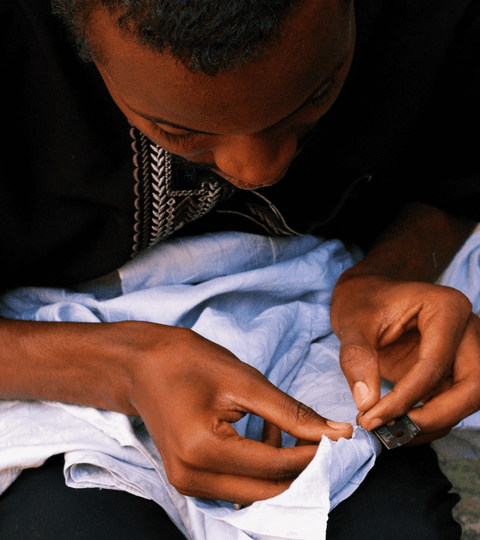How to Repair, Refresh & Reconnect With Your Clothes
Our world is overflowing with cheap garments built to be disposable. But clothes aren’t meant to be trash. They’re made to be worn, loved, repaired—and ideally, passed along or re-loved by someone else. At Scarlet Destiny, our ethos is about extending the life of what we already own before buying new, reducing waste, and appreciating craftsmanship. Taking care of your clothes is one of the most powerful acts of sustainability you can offer, not just for the planet, but for your own sense of connection to what you wear.
How to Fix Common Clothing Problems at Home
When zips jam, sweaters pill, or stains linger, many people toss things aside. But with a handful of skills and intention, common clothing issues can be repaired, refreshed, and re-cherished. In doing this, we reclaim style, preserve resources, and nurture garments into becoming more than just items—but pieces of our story.
1. Zipper troubles
When zippers stick, a dry bar of soap rubbed along the teeth often does the trick. If the slider is damaged, zipper repair kits are inexpensive and surprisingly simple. When parts are too far gone, a tailor’s services can breathe new life into the item.
2. Pilling
Tiny fuzz balls might look inevitable, but they don’t have to stay. A fabric shaver or a clean razor (used very gently) can remove pills without damaging knit fabrics. Washing clothes inside out, choosing gentler cycles, and avoiding overloading the washing machine all help reduce friction that causes pilling.
3. Loose threads and seams
Pulling on loose threads only makes things worse. For shorter ones, tucking them back inside seams works. Longer ones are best re-stitched with a matching needle and thread. For hems or delicate edges, fabric glue or fray check helps prevent further unravelling.
4. Stubborn stains and odours
For sweat or odour marks, create a paste with baking soda and water, apply gently, let sit, then wash as usual. Where possible, spot-clean rather than wash the entire garment, since frequent washing wears fabrics out faster.
5. Scuffed or dirty shoes and footwear
Leather shoes benefit from leather conditioner or even petroleum jelly applied with a soft cloth; white sneakers can often be revived with a white eraser or gentle paste made from baking soda. For suede, a soft brush or dry tools are best (water and suede generally don’t mix).
Relearning to Love What You Own
Fixing is one thing, but love is another. Clothing that’s neglected, shoved in the back of wardrobes, or forgotten tends to feel less inspiring. Here are practices that help you fall back in love with your wardrobe:
- Spend time with your wardrobe: Spread everything out, try things on, see what still speaks to you. You might rediscover forgotten favourites.
- Purposeful dressing: Choose pieces you really love, even at home. When you wear something beautiful or meaningful, it lifts mood and confidence.
- Refresh without full wash: Sometimes airing out, spot-cleaning, using a garment steamer or airing it in fresh air is enough to make something feel new again.
- Upcycle creatively: Use fabric markers, natural dyes (onion skins, avocado pits, etc.), patches, or embroidery to refresh vintage or stained garments.
- Learn basic mending: Sewing on a button, patching a hole, or even doing visible mending makes a difference, and it's deeply satisfying.
Looking At The Bigger Picture: Repair as Part of Circular Fashion
Repair isn’t just a personal skill; it’s a vital link in creating a more sustainable fashion system. More brands and retailers are beginning to offer repair, alteration, and tailoring services as part of circular fashion models, helping extend the lifespan of garments and keeping them in use for longer.
Visible mending, the practice of allowing repairs to be seen rather than hidden, has also gained traction, transforming flaws into features and encouraging us to reframe our relationship with imperfections. At the same time, consumers who learn to mend, care for fabric properly, and buy more thoughtfully are sending an important message to the industry: design for repair, use durable fabrics, and provide support beyond the point of sale.
Repairing and caring for what we own is not old-fashioned, it’s revolutionary. At Scarlet Destiny, our mission is to inspire, and give you the tools, to move away from disposable fashion, and toward wardrobes full of pieces that last longer, mean more, and do less harm. Clothes are not just what we wear; they embody memories, values, and our relationship with the planet. So next time a zipper jams, a seam loosens, or your favourite top seems stained beyond saving, pause. Fix. Refresh. Love again.
Because sustainability isn’t only about what we buy—it’s how we live with what we already have. So next time a zip jams, a seam loosens, or your favourite top looks beyond saving—pause. Fix it. Refresh it. Love it again. Because sustainability isn’t only about what we buy—it’s how we live with what we already have.
Want to mend more?
Start with some of our favourite repair guides and services that support stylish, sustainable care: Loved Clothes Last by Orsola de Castro, Mend! by Kate Sekules, and Visible Mending by Arounna Khounnoraj. And if you’re after hands-on help, try The Seam, the Sojo app, or the beautifully mindful work of @flk_atelier. Already a mender? We’d love to know—where did you learn your repair skills?
Sources: bbc.co.uk and fashionforgood.com


0 Comments
There are no comments yet. Be the first one to post one!